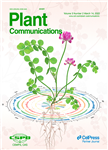The Past, Present, and Future of Maize Improvement: Domestication, Genomics, and Functional Genomic Routes toward Crop Enhancement
作者机构:National Key Laboratory of Crop Genetic ImprovementHuazhong Agricultural UniversityWuhan 430070China Department of Molecular PhysiologyMax-Planck-Institute of Molecular Plant PhysiologyAm Muhlenberg 114476 Potsdam-GolmGermany
出 版 物:《Plant Communications》 (植物通讯(英文))
年 卷 期:2020年第1卷第1期
页 面:38-56页
核心收录:
学科分类:0710[理学-生物学] 07[理学] 09[农学] 071007[理学-遗传学] 0901[农学-作物学] 090102[农学-作物遗传育种]
基 金:This work was supported by the National Natural Science Foundation of China(31961133002,31901549,and 31525017) the Ministry of Agriculture of China(2018ZX0801004B)
主 题:maize domestication genomics functional genomics improvement
摘 要:After being domesticated from teosinte,cultivated maize(Zea mays ***)spread worldwide and now is one of the most important staple *** to its tremendous phenotypic and genotypic diversity,maize also becomes to be one of the most widely used model plant species for fundamental research,with many important discoveries reported by maize ***,we provide an overview of the history of maize domestication and key genes controlling major domestication-related traits,review the currently available resources for functional genomics studies in maize,and discuss the functions of most of the maize genes that have been positionally cloned and can be used for crop ***,we provide some perspectives on future directions regarding functional genomics research and the breeding of maize and other crops.



